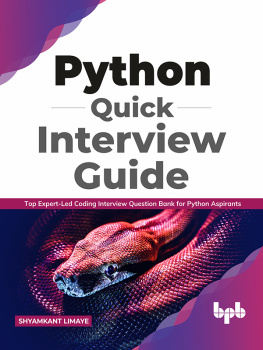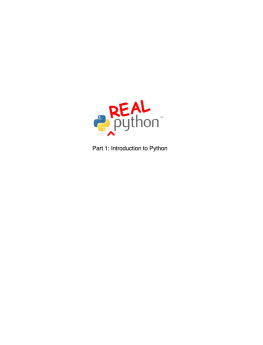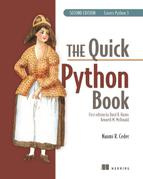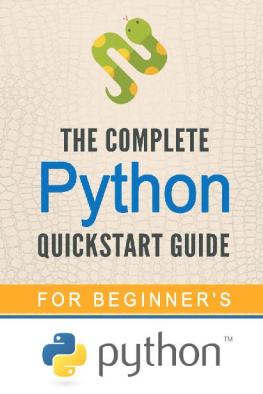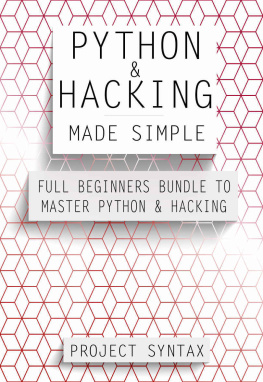Shyamkant Limaye - Python Quick Interview Guide
Here you can read online Shyamkant Limaye - Python Quick Interview Guide full text of the book (entire story) in english for free. Download pdf and epub, get meaning, cover and reviews about this ebook. year: 2021, publisher: BPB Publications, genre: Computer. Description of the work, (preface) as well as reviews are available. Best literature library LitArk.com created for fans of good reading and offers a wide selection of genres:
Romance novel
Science fiction
Adventure
Detective
Science
History
Home and family
Prose
Art
Politics
Computer
Non-fiction
Religion
Business
Children
Humor
Choose a favorite category and find really read worthwhile books. Enjoy immersion in the world of imagination, feel the emotions of the characters or learn something new for yourself, make an fascinating discovery.
- Book:Python Quick Interview Guide
- Author:
- Publisher:BPB Publications
- Genre:
- Year:2021
- Rating:4 / 5
- Favourites:Add to favourites
- Your mark:
- 80
- 1
- 2
- 3
- 4
- 5
Python Quick Interview Guide: summary, description and annotation
We offer to read an annotation, description, summary or preface (depends on what the author of the book "Python Quick Interview Guide" wrote himself). If you haven't found the necessary information about the book — write in the comments, we will try to find it.
Python Quick Interview Guide — read online for free the complete book (whole text) full work
Below is the text of the book, divided by pages. System saving the place of the last page read, allows you to conveniently read the book "Python Quick Interview Guide" online for free, without having to search again every time where you left off. Put a bookmark, and you can go to the page where you finished reading at any time.
Font size:
Interval:
Bookmark:

Interview Guide

Question Bank for Python Aspirants


www.bpbonline.com
FIRST EDITION 2021
Copyright BPB Publications, India
ISBN: 978-93-89423-30-3
All Rights Reserved. No part of this publication may be reproduced, distributed or transmitted in any form or by any means or stored in a database or retrieval system, without the prior written permission of the publisher with the exception to the program listings which may be entered, stored and executed in a computer system, but they can not be reproduced by the means of publication, photocopy, recording, or by any electronic and mechanical means.
LIMITS OF LIABILITY AND DISCLAIMER OF WARRANTY
The information contained in this book is true to correct and the best of authors and publishers knowledge. The author has made every effort to ensure the accuracy of these publications, but publisher cannot be held responsible for any loss or damage arising from any information in this book.
All trademarks referred to in the book are acknowledged as properties of their respective owners but BPB Publications cannot guarantee the accuracy of this information.
Distributors:
BPB PUBLICATIONS
20, Ansari Road, Darya Ganj
New Delhi-110002
Ph: 23254990/23254991
MICRO MEDIA
Shop No. 5, Mahendra Chambers,
150 DN Rd. Next to Capital Cinema,
V.T. (C.S.T.) Station, MUMBAI-400 001
Ph: 22078296/22078297
DECCAN AGENCIES
4-3-329, Bank Street,
Hyderabad-500195
Ph: 24756967/24756400
BPB BOOK CENTRE
376 Old Lajpat Rai Market,
Delhi-110006
Ph: 23861747

Published by Manish Jain for BPB Publications, 20 Ansari Road, Darya Ganj, New Delhi-110002 and Printed by him at Repro India Ltd, Mumbai
www.bpbonline.com
Smita, my charming wife,
without whose silent support this project would never
have been possible.
Professor Shyamkant Limaye spent 18 years in the computer industry and 30 years in teaching the students of Electronics Engineering. His experience includes a 2-year stint as a System Analyst in the USA. In 1971, he graduated from the Visvesvaraya National Institue of Technology in Electrical engineering with a gold medal. He did his Masters from IIT Kanpur, and is a Doctorate in Electronics from RTM Nagpur University. He has guided 10 students for PhD. He has published a textbook on VHDL programming in 2007. He has also published a thriller novel entitled Dual reality in 2011. He retired as a Professor in Electronics and Telecomm Dept. at St. Vincent Pallotti College of Engineering and Technology, Nagpur.
Dr. Manoj B. Chandak is head of Computer Science and Engineering at Ramdeobaba College of Engineering and Management, Nagpur. He holds a Ph.D. in Computer Science and Engineering from Nagpur University. He also holds M.E. in Computer science where he was a topper and B.E. in Computer Technology from Nagpur university where he stood second. He is an acknowledged academician with over 22 years of teaching experience with more than 60 research publications in referred journals and conferences. A recognized supervisor in doctoral research in RTM Nagpur University and SGB Amravati University, his research interests are in NLP, Big Data, Information Retrieval, and Mobile & Wireless Technology. He conducts courses in Design and Analysis of Algorithms, Language Processing [Compiler Design], Advances in Algorithms, and Natural Language Processing.
There are a few people I want to thank for helping me to bring this book into existence.
First is Mr. Rohan Vaidya, my young colleague at St. Vincent Pallotti College of Engineering and Technology. He urged me to learn Python because he said that tomorrows engineers and scientists are going to need it, and as a teacher, it was my duty to teach them. I have been a diehard fan of C++ for the most of my life. But due to Rohans persuasion, I decided to learn Python. Interestingly, it was my B.E. final year student, Pravesh Bawangade, who gave me the first lesson of Python. I found the language to be really useful.
After interacting with students going for campus interviews, I realized that there are many introductory books on Python and many advanced level books dealing with the data science and artificial intelligence. But, there is no book that grills them into coding and teaches algorithms and data structures from a competition point of view. I, therefore, decided to write this book.
I am thankful to my colleagues Dr. Ms. Hema Kale, Dr. Manoj Chandak, and Dr. Rajesh Pande, for going through my early drafts and giving valuable suggestions.
Finally, I must thank BPB Publications for accepting my idea and giving continuous support during the editing process.
It gives me great pleasure to offer this book to the students. C++ was invented in 1979 and Python was invented 10 years later, in 1989. C++, and its cousin Java, ruled the programming world for many years. However, they are loosening their grip now. Python offers more flexible language constructs and platform independence. But the recent upsurge in the demand for Python is triggered by a rich set of libraries in the public domain, especially in the area of artificial intelligence (AI).
Many excellent books have been written on the Python programming. Some are basic and some teach advanced topics, like, machine learning and deep learning. But to get into a good company, firstly, a student has to clear an aptitude test and a coding test. While many books exist on the aptitude preparation, there is a dearth of books to prepare the students for a coding interview. The standard university curriculum does not provide this knowledge. The coding test can be given in many languages like C, C++, or Java. However, since Python is the language of the future, it is better to give it in Python.
There are some resources available on the internet, but they are scattered over many places, and they neither provide proper explanation, nor provide a graded path from easy to hard problems. Moreover, one cannot become a coding wizard merely by copy-pasting somebodys code without understanding. That is precisely why this book has been written. In addition, a college may choose this book as a reference book for the lab courses in Python.
It is not possible to cover all the possible problems in a small book. But it is neither necessary, nor desirable. The 75 problems presented in this book will guide the students to the path of self-reliance and confidence.
Every year, the placement agencies and IT companies conduct coding tests for the graduating batch. Many of them use an artificial intelligence-based evaluation tool that senses the logic of the students. If you get the answer right, it is good. But, even if you dont get a valid answer, or cannot remove the compilation errors, or cannot remove the run time errors, the tool is able to sense your logic. It is also able to sense the time complexity and the space complexity of the code. Most companies in India, and abroad, use similar sets of questions and similar evaluation tools. In general,
Font size:
Interval:
Bookmark:
Similar books «Python Quick Interview Guide»
Look at similar books to Python Quick Interview Guide. We have selected literature similar in name and meaning in the hope of providing readers with more options to find new, interesting, not yet read works.
Discussion, reviews of the book Python Quick Interview Guide and just readers' own opinions. Leave your comments, write what you think about the work, its meaning or the main characters. Specify what exactly you liked and what you didn't like, and why you think so.

